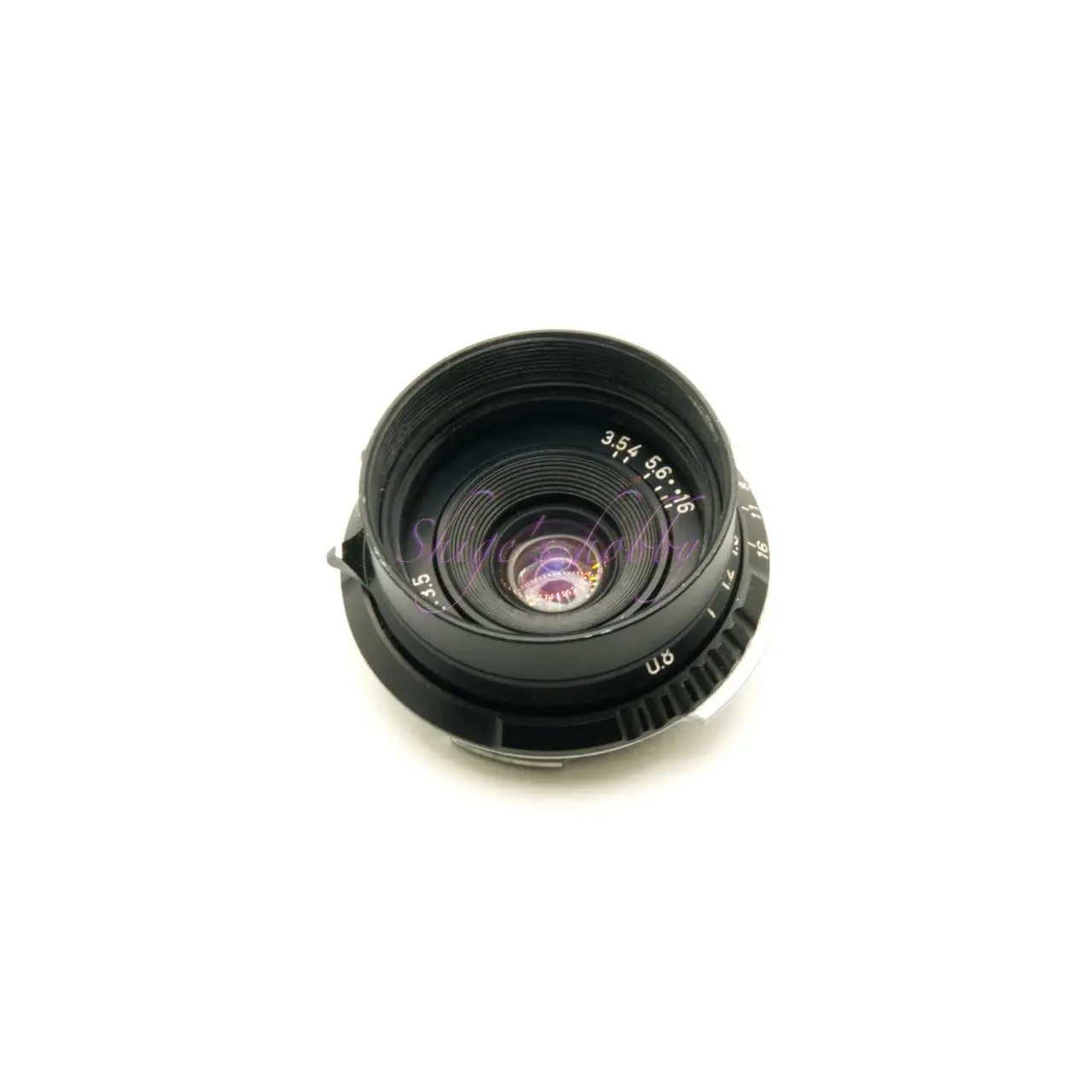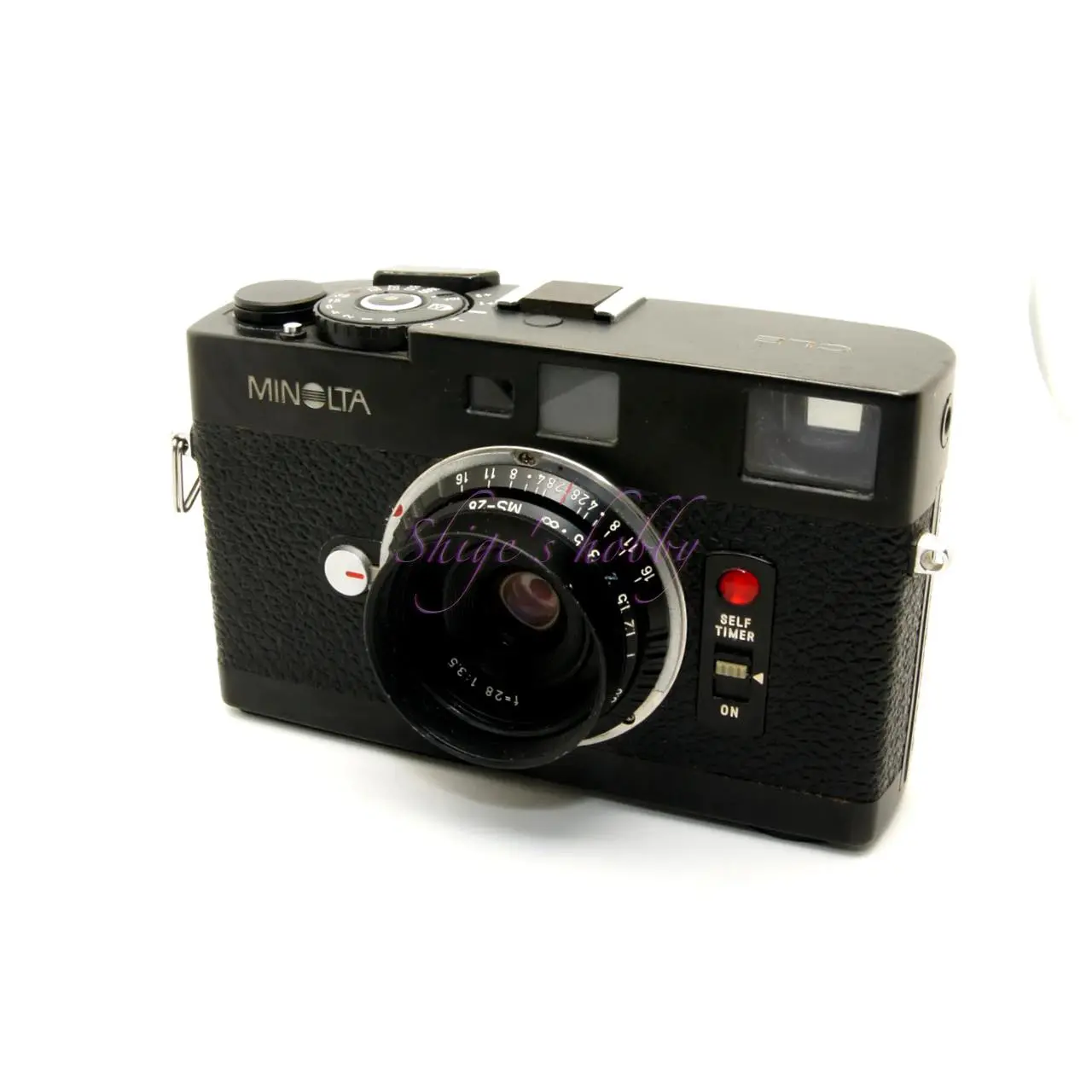A review and sample photos of the SUPER EBC FUJINON 28mm F3.5 lens mounted on the compact camera TIARA, modified to M mount, used with digital and film cameras.
- Please see the disclaimer regarding advertising here.
- Italicized links in the text are advertisement links that take you to other sites.
Table of contents
Gallery
The digital camera example was taken using the SONY α7sII and Minolta CLE + FUJIFILM 100.
Review


1.Overview
The Fujinon 28mm F3.5 is a lens that Ms-optics (Miyazaki Optical) took the SUPER-EBC FUJINON 28mm F3.5 lens installed in Fujifilm’s compact cameras, the Caldia Mini Tiara (TIARA), Caldia Mini Tiara II (TIARA II), and DL Super mini, and transplanted it to the Leica M-mount conversion helicoid MS-28 developed by the same company.
The original TIARA is a compact camera that uses 35mm film, and the lens is a single focus lens with a focal length of 28mm. It is very small because it is a simple lens that does not take into consideration aberration correction or peripheral light amount.
Therefore, the modified lens is compact with a lens length of 18mm even with the addition of a dedicated lens hood.
The main specifications are as follows, and detailed specifications are listed in the table.
- Aperture value 3.5
- Lens composition 4 elements in 4 groups
- Aperture blades 12 (installed by Ms-Optics)
- Minimum shooting distance 0.85m
- Leica M rangefinder camera rangefinder coupling 0.85m
- Hood Cylindrical screw-in
2.Usability
The Fujinon 28mm f/3.5 M-mount modified lens, described in detail below, can be easily disguised with film cameras, but digitalization results in significantly worse peripheral image quality. These results demonstrate the significant difference in lens performance required for film and digital cameras.
Ghosting can occur in backlit situations depending on the orientation of the light source.
The lens’s compact design sacrifices operability, and while the lens and camera mount fit together securely and securely, removing it can be a bit difficult due to the lens’s poor grip. Additionally, the aperture control ring is located right on the edge of the front element, so caution is required to avoid accidentally touching the front element when adjusting the aperture.
The M-mount helicoid MS-28 attached to this lens is an older model, with a helicoid extension range limited to the rangefinder coupling range of the M-type Leica, resulting in a minimum focusing distance of 0.85m.
This is a shame, considering the original Tiara lens could get as close as 0.35m.
One of the characteristics of the lens I own is that the hood cannot be removed, although I’m not sure if it’s stuck or fixed in place. The original mount is supposed to be an L39 screw mount, but the M/L ring seems to be fixed and cannot be removed either.
■Film rangefinder camera
The film was shot with a MINOLTA CLE body and Fujifilm 100 film. The lens was a good match for the film, with no noticeable image quality issues, and the slightly loose imagery of negative film was a good match for the lens.
It’s rare to use reversal film with a compact camera, but with reversal film’s fine grain, you might expect the roughness around the edges to become noticeable.
As an aside, this is a problem with the camera I used, but the MINOLTA CLE body was purchased with the lens and is quite worn, so the double image that occurs when focusing had completely faded, making it difficult to focus.
This lens is relatively prone to ghosting, so when shooting with a rangefinder camera, which views from a different perspective than the lens, it’s important to understand the lens’s quirks and take measures to prevent it. The same applies if you want to intentionally create ghosting.
■ Mirrorless camera
The digital camera used for this shoot was the Sony α7sII, which is relatively compatible with old lenses.
Looking at the results from the α7sII, we can see that the image is fine in the center, but distorted at the edges.
Looking at the results from the Sony α NEX-C3 and NEX-6, which have APS-C sensors, we can see that peripheral distortion can also be seen on sensors smaller than 35mm film. Because APS-C sensors are smaller than 35mm film, the focal length during shooting is 1.5 times larger, equivalent to 42mm in 35mm format. While 42mm barely feels like a wide-angle lens, the shooting interval is closer to that of a standard lens.
A 4/3 sensor, which is 1/4 the area of a 35mm film sensor, almost completely eliminates peripheral distortion and records only the clear image at the center of the lens, making it a fairly ordinary lens. However, because the focal length is doubled, the focal length is equivalent to 56mm in 35mm format, so it cannot be used as a wide-angle lens.
With mirrorless cameras, you can directly view the image captured by the sensor, making it easier to deal with ghosting.
Furthermore, based on past experience, with cameras equipped with 35mm full-frame sensors, there is a possibility of color casts occurring in the peripheral areas of the image. This is probably most prevalent with cameras equipped with older 35mm full-frame sensors, such as the LEICA M9 and LEICA M typ240.
For practical use with digital cameras, this lens is best used with the APS-H size sensor of the LEICA M8, the APS-C size sensor of the Fujifilm X or Sony α6x series, or a 4/3 sensor.
As for the lack of a minimum focusing distance, this can be compensated for with mirrorless cameras by using auxiliary helicoids sold by various companies. When using with a mirrorless camera, this is something we recommend making active use of.
3.Summary
In conclusion, to sum up the Fujinon 28mm F3.5 has sufficient performance for using negative film with a film camera, but it is difficult to use with a digital camera in many situations where peripheral light falloff and color cast are noticeable.
The same phenomenon occurs with APS-C size sensors, which have a smaller surface area than 35mm full-frame sensors, so it is likely that the lens’s image circle is insufficient to begin with.
Specifications, considerations, etc.
The nameplate on this lens simply reads “28mm f/3.5” and does not include any “Tess” or other designation of the lens, as is the case with Kyocera T-Proof and Tessar lenses. Therefore, to identify the lens used, I searched for a compact camera equipped with a 28mm f/3.5 prime lens before purchasing it. The only cameras equipped with a 28mm f/3.5 prime lens that remained were the Fujifilm Tiara (Tiara II) and the Nikon Nikon Mini (AF600D), and based on the shape of the lens front frame, I determined that it was most likely a Tiara. Furthermore, I was convinced that it was definitely a Tiara after seeing photos of the modified Tiara lens on Hayata Camera Lab’s Miyazaki Optical Lens Modification page.
If you send a camera to Ms-optics and request a modification, they will return the original body with the lens removed, so it is easy to identify the original camera. However, this time I purchased the lens attached to a Minolta CLE from a second-hand shop in Okinawa for a reasonable price, even though it was treated as junk, so I do not know whether the original body was a Tiara or Tiara 2.
When I looked up the lens information on the website in the reference link before purchasing, I was a little hesitant to purchase it because it said that Tiara lenses are lenses from the film era, so you can’t expect good depiction in the peripheral areas and they don’t work well with digital cameras. However, as an Ms-optics modified lens enthusiast, I couldn’t resist the temptation to use this lens and purchased it.
Trivia about the Cardia Mini Tiara
- Released in 1994
- Equipped with a 28mm prime lens in a compact aluminum body. Received the Good Design Award in 1995.
Trivia about the Cardia Mini Tiara 2
- Released in 1997
- Improved successor to the first model. Exposure accuracy has been improved, and changes have been made to the strobe.
The website explaining compact cameras in the reference link states that there seems to be a difference in the lens coating between the Tiara and Tiara 2, which makes the image look different, but since there is no way to compare them at the moment, the truth is unknown. I also looked online for lens configuration diagrams and looked at old camera magazines, but it seems that Fujifilm does not openly disclose lens configuration diagrams, and all I know is that it uses 4 groups, 4 elements, and aspherical lenses. I don’t want to buy a junk Tiara and cut it in half, so I don’t know the lens configuration. If you have any information, please let me know.
| Items | FUJIFILM TIARA | Nikon mini(AF600) | RICOH GR1 |
| Focal length(mm) | 28 | ← | ← |
| Max aperture | 3.5 | 3.5 | 2.8 |
| Min aperture | 16 | ← | ← |
| Lens Construction | 4elements in 4groups | 3elements in 3groups | 7elements in 4groups |
| Leaf blade | 12(Ms-Optics modified | ← | 7 |
| Min distance(m) | 0.85 | 0.85 | 0.35 |
| Lens length(mm) | 18.2 Hood included | – | – |
| Max diameter(mm) | 47.6 | – | – |
| Filter Size(mm) | – | – | – |
| Hood | Cylindrical screw-in hood | Bayonet hood LH-6 | none |
| Release date | 1994 (Tiara) 1997 (Tiara 2) | 2004 | 1996 |
| Production number | 15 (number of modifications as of 2016) | – | – |
| Weight(g) | 60 Hood and M/L rings included | – | 120 |
Reference links
- Hayata Camera Lab Miyazaki Optical Lens Modification Guide
- Playing with lens modifications FUJIFILM TIARA SUPER-EBC FUJINON 28mmf3.5
- Let’s play with a slightly old camera – Tiara
- Let’s play with a slightly old camera – Tiara 2
- Analog.cafe fujifilm Cardia Tiara / DL Super Mini review
Affiliate link
- Please see the disclaimer regarding advertising here.
- Italicized links in the text are advertisement links that take you to other sites.
- Amazon Affiliate link for FUJIFILM camera
- Amazon Affiliate link for FUJIFILM books
- Amazon Affiliate link for Ms-optics

Update history
- 2025.11.14
- 2025.3.26
- 2024.8.5



Be First to Comment